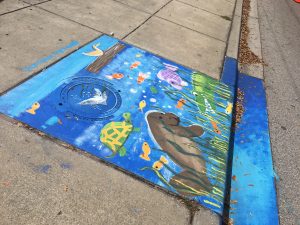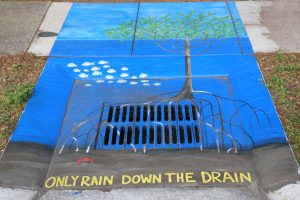
[su_pullquote align=’right’] Stormdrain mural in Pinellas Park. Photo provided by City of Pinellas Park.[/su_pullquote]
Is it art? Is it education? These murals are both.
Stormdrains — those holes on the side of the road where water runs when it rains — connect nearly every neighborhood in the region almost directly to the bay or nearby pond or river. When stormwater travels, it carries contaminants like oil, fertilizer and litter.
“A lot of people don’t realize that stormwater drains don’t run to treatment plants where pollution and litter are removed,” says Kyle Arrison, stormwater supervisor for the city of Pinellas Park. “In almost every case, they just run to larger drains or ditches that eventually end up in the bay or nearby surface water.”
These new murals in Pinellas Park, funded through a grant program from the Florida Department of Transportation in partnership with the Tampa Bay Regional Planning Council, are an intersection of art and education. They highlight our own role in preventing pollution.

“We’ve gotten a lot of great feedback, including from people, phone calls and online comments, about the murals,” Arrison said. “People don’t necessarily even know what a stormwater drain is, or what happens to anything they put in them.”
Since dealing with many of the significant point sources of pollution — like wastewater treatment and power plants — decades earlier, stormwater is now the single largest source of pollution to Tampa Bay. That’s how the empty water bottles, cigarette butts, styrofoam cups, plastic straws and chemicals end up in local waterways.
Recognizing the need for information, cities across the region are creating murals and posting signs that inform people that only water belongs in stormwater drains. Last year, in partnership with the city of Tampa, Keep Tampa Bay Beautiful volunteers painted stormwater drain murals in Tampa.
This past summer, Pinellas Park worked with artists to paint five stormwater drains near a middle school and a senior center — both areas with higher-than-average foot traffic — to increase visibility and educational opportunities.
“We think this kind of public art can be an effective tool in reaching the public to inspire actions and activities that positively impact our waterways,” says Arrison.
 The goal of the murals is to ensure that stormwater — a vitally important freshwater source for the low-salinity habitats that make estuaries so productive — stays clean for the fish and other critters that depend upon them.
The goal of the murals is to ensure that stormwater — a vitally important freshwater source for the low-salinity habitats that make estuaries so productive — stays clean for the fish and other critters that depend upon them.
The old adage, “only rain down the drain,” is a theme of many stormdrain murals for both water quality and flood prevention. “A drain that’s clogged with empty water bottles just isn’t going to let as much water through as it could,” he adds.
Even grass clippings and leaves count as “no-no’s” in stormwater drains. They contain high levels of nutrients that fuel harmful algal blooms and attract more mosquitoes to your neighborhood. Grass clippings also slow down the flow of stormwater can lead to localized flooding.
Remember the slogan — only rain down the drain — and do your part to keep Tampa Bay clean!
[su_divider top=”no” style=”double” divider_color=”#5330f0″ margin=”25″]
Interested in stormdrain murals? We’ve compiled a few resources from around the country for you to peruse on our Pinterest Board!
[su_divider]